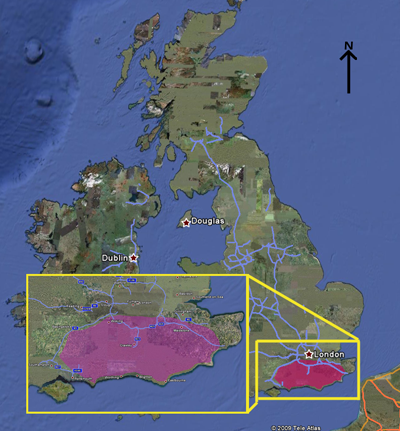This case study is set in the southeast of England in a basin known as the Weald. The location of the Weald can be seen on this map:

Geological History
When exploring for hydrocarbons, it is important to know the geological history of an area before any geophysical work is undertaken. For an oil reservoir to be present there are three main requirements of the geology:
- A suitable source rock is in the vicinity. This needs to be rich in organic material and of a suitable age that the changes of hydrocarbon maturation can have taken place.
- A suitable reservoir quality rock is present. This rock needs to have sufficient permeability and porosity to allow it to hold significant quantities of oil and gas.
- A cap rock or a structural trap is present to keep the hydrocarbons within the reservoir and not allow them to migrate away.
The first information comes from geological mapping of the surface. If we look at the solid geology map we can see that in our area of interest there are several types of rock, and some structures too. From this a cross section can be created. This cross section and the map only show the geology near the surface.
Look at the stratigraphic column for the south of England (358 KB pdf) and see which of these rocks occur on the solid geology map.
Now look to see which rocks in the stratigraphic column are organic rich and so potential source rocks for hydrocarbons.
The geology at the surface does not necessarily show any of the rocks or structures at depth, which could well be different. It is then that geophysical methods can help to reveal what is deep below.
Click here to see a geological cross section of the area derived from seismic studies (402 KB pdf).
Download high resolution versions of cross section and stratigraphic column (1.5 MB zip).
Exploration History
The first interest in hydrocarbon exploration was shown as early as the 1930s, geological surface mapping and gravity surveys indicated rocks of the correct age and type and so the likely presence of hydrocarbons. Wells drilled in the area did indeed show the presence of oil and gas. However, the quantities found in the Weald were not sufficient for the area to become commercially productive at that time.
In 1973 the oilfield at Wytch farm just further south of the Weald was discovered. Here the surface geology was very different from the geology at depth, and applying this realization to the Weald, a new phase of hydrocarbon exploration commenced.
As technology and oil prices have changed, places once thought of an uneconomic can become viable reservoirs and may also be put to new uses. An example is the Humbly Grove oilfield which is also used for gas storage. The gas is pumped into the reservoir when it is cheap, such as in the summer months when demand for heating is less, and can be sold in the winter at a better price. The pressure of the gas also helps to extract more oil from the reservoir.
More detail about Humbly Grove can be found at http://www.pesgb.org.uk/events/event-39/


